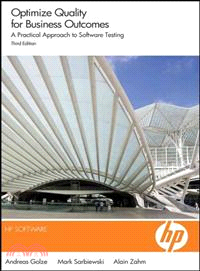A PRACTICAL APPROACH TO SOFTWARE TEST
商品資訊
ISBN13:9780470404669
出版社:JOHN WILEY & SONS;LTD
作者:Andreas Golze; Mark Sarbiewski; Alain Zahm
出版日:2008/06/13
裝訂:平裝
商品簡介
目次
相關商品
商品簡介
Published in partnership with HP, this guide shares more than 20 years of software testing wisdom from both HP consultants and customers aimed at improving performance measurement. You’ll learn from the experts how to move through software development and testing processes in the most effective, cost-efficient way as you examine fundamental questions around testing from a business perspective: what to test and how to assure that testing has accomplished its objective, the various behavioral modeling methods, using key performance indicators, and more.
目次
Acknowledgements.
Introduction.
Chapter 1 What Is the Big Deal About Testing?
Quality Goals and Test Phases.
Requirements Verification.
Unit Test.
Integration Test.
System Test.
Performance Test.
User Acceptance Test.
Operational Readiness Test.
Case Study: Flight Application.
Requirements Verification.
Unit Test.
Integration Test.
System Test.
Performance Test.
User Acceptance Test.
Operational Readiness Test.
Test Concepts and Techniques.
White-Box Testing.
Black-Box Testing.
Wrapping Up.
Chapter 2 Testing the Business Requirements: Start at the Root of the Problem.
Build a Common Reference.
Document the Separate Business Functions.
Link Requirements into the Structure.
Define Proof Points.
Chapter 3 Test Rules: Build the Backbone for Effective Testing.
Equivalence Partitioning with Root Cause Analysis.
Chapter 4 Test Cases: Let’s Get Down to the Real Stuff.
Step 1: Select a Test Rule.
Step 2: Specifying Master Data.
Take Data from Production.
Build Data Using the Existing Application.
Generate Data from Scratch.
Step 3: Finalize the Test Case Description.
Test Scenarios.
Test Execution.
Chapter 5 Test Optimization: Balancing Risk and Effort.
Risk Assessment.
Business Impact Analysis.
Failure Probability.
Derive Business Risk.
Test Procedure Definition.
Functional Complexity.
Test Effort Estimation.
How to Calculate the Optimal Level of Automation.
Test Effort Optimization.
Improving Test Automation and Manual Testing.
Improving Regression Test Efficiency.
Chapter 6 Why Bother with Non-Functional Testing?
Non-Functional Scope.
Performance.
Load.
Availability.
Reliability.
Consider Non-Functional Testing at the Business Level.
Performance Testing.
Step 1: Defining Performance Requirements.
Step 2: Performance Breakdown.
Step 3: Performance Instrumentation.
Step 4: Performance Test Execution.
Step 5: Performance Test Analysis.
Step 6: Performance Enhancements.
Load Testing.
Step 1: Stability.
Step 2: Load Support.
Step 3: Scalability.
Step 4: Sustainability.
Step 5: Overload.
Availability Testing.
Expressing Availability.
Turning Availability Rate into Concrete Terms.
High Availability Testing.
Reliability Testing.
Reliability Requirements.
Reliability Testing.
Non-Functional Testing Critical for Success.
Chapter 7 Application Security Testing: The Next Frontier.
Understanding the Application Security Problem.
The Technical Problem.
The Lifecycle Problem.
The Business Problem.
The Solution.
Enterprise Security Strategy and Policies.
Process and Practices.
Education and Training.
Key Stakeholders.
Technology.
Static Analysis (aka Source Code Analysis).
Dynamic Analysis (aka Black-Box Testing).
Hybrid Analysis.
Secure Code Libraries.
Continuously Updated Security Knowledge-Bases.
So Where Does That Leave Us?
Chapter 8 Test Sourcing: How Outsourcing Improves.
Cost Effective Testing.
Why — and How — Does Outsourcing Work in Other Industries?
Successful IT Outsourcing.
Step 1: Test Rule Definition.
Step 2: Test Data Specification.
Step 3: Data Load Procedures.
Step 4: Test Script Development.
Step 5: Compare Utility Development.
Step 6: Automated Test Evaluation.
Step 7: Manual Test Execution.
Step 8: Test Evaluation.
Chapter 9 SUCCESSFUL Goal-Driven KPI Approach.
Set Business Goals.
Understand the Impact of Each Department on Business Goals.
Choose Supporting Business Processes.
Create Business Process Goals.
Examine What to Measure.
Standardize Measurements Across Departments.
Scope Data Source and Integration Needs.
Formalize Indicators and Thresholds.
Utilize and Execute Appropriate Action Plans.
Lay the Groundwork and Baseline.
Chapter 10 Getting Started: Putting It All Together.
Level 0: Quality Agnostic.
Level 1: Quality Initializing.
Process Characteristics.
Product Characteristics.
People Characteristics.
Level 2: Quality Conscious.
Process Characteristics.
Product Characteristics.
People Characteristics.
Level 3: Quality Savvy.
Process Characteristics.
Product Characteristics.
People Characteristics.
Level 4: Quality Expert.
Process Characteristics.
Product Characteristics.
People Characteristics.
Self Evaluation — Designing a Roadmap.
Appendix A Common Test Techniques.
Appendix B HP Application Quality Management Solutions Introduction and Overview.
Appendix C Verification.
Appendix D Naming Conventions.
References.
Glossary.
Introduction.
Chapter 1 What Is the Big Deal About Testing?
Quality Goals and Test Phases.
Requirements Verification.
Unit Test.
Integration Test.
System Test.
Performance Test.
User Acceptance Test.
Operational Readiness Test.
Case Study: Flight Application.
Requirements Verification.
Unit Test.
Integration Test.
System Test.
Performance Test.
User Acceptance Test.
Operational Readiness Test.
Test Concepts and Techniques.
White-Box Testing.
Black-Box Testing.
Wrapping Up.
Chapter 2 Testing the Business Requirements: Start at the Root of the Problem.
Build a Common Reference.
Document the Separate Business Functions.
Link Requirements into the Structure.
Define Proof Points.
Chapter 3 Test Rules: Build the Backbone for Effective Testing.
Equivalence Partitioning with Root Cause Analysis.
Chapter 4 Test Cases: Let’s Get Down to the Real Stuff.
Step 1: Select a Test Rule.
Step 2: Specifying Master Data.
Take Data from Production.
Build Data Using the Existing Application.
Generate Data from Scratch.
Step 3: Finalize the Test Case Description.
Test Scenarios.
Test Execution.
Chapter 5 Test Optimization: Balancing Risk and Effort.
Risk Assessment.
Business Impact Analysis.
Failure Probability.
Derive Business Risk.
Test Procedure Definition.
Functional Complexity.
Test Effort Estimation.
How to Calculate the Optimal Level of Automation.
Test Effort Optimization.
Improving Test Automation and Manual Testing.
Improving Regression Test Efficiency.
Chapter 6 Why Bother with Non-Functional Testing?
Non-Functional Scope.
Performance.
Load.
Availability.
Reliability.
Consider Non-Functional Testing at the Business Level.
Performance Testing.
Step 1: Defining Performance Requirements.
Step 2: Performance Breakdown.
Step 3: Performance Instrumentation.
Step 4: Performance Test Execution.
Step 5: Performance Test Analysis.
Step 6: Performance Enhancements.
Load Testing.
Step 1: Stability.
Step 2: Load Support.
Step 3: Scalability.
Step 4: Sustainability.
Step 5: Overload.
Availability Testing.
Expressing Availability.
Turning Availability Rate into Concrete Terms.
High Availability Testing.
Reliability Testing.
Reliability Requirements.
Reliability Testing.
Non-Functional Testing Critical for Success.
Chapter 7 Application Security Testing: The Next Frontier.
Understanding the Application Security Problem.
The Technical Problem.
The Lifecycle Problem.
The Business Problem.
The Solution.
Enterprise Security Strategy and Policies.
Process and Practices.
Education and Training.
Key Stakeholders.
Technology.
Static Analysis (aka Source Code Analysis).
Dynamic Analysis (aka Black-Box Testing).
Hybrid Analysis.
Secure Code Libraries.
Continuously Updated Security Knowledge-Bases.
So Where Does That Leave Us?
Chapter 8 Test Sourcing: How Outsourcing Improves.
Cost Effective Testing.
Why — and How — Does Outsourcing Work in Other Industries?
Successful IT Outsourcing.
Step 1: Test Rule Definition.
Step 2: Test Data Specification.
Step 3: Data Load Procedures.
Step 4: Test Script Development.
Step 5: Compare Utility Development.
Step 6: Automated Test Evaluation.
Step 7: Manual Test Execution.
Step 8: Test Evaluation.
Chapter 9 SUCCESSFUL Goal-Driven KPI Approach.
Set Business Goals.
Understand the Impact of Each Department on Business Goals.
Choose Supporting Business Processes.
Create Business Process Goals.
Examine What to Measure.
Standardize Measurements Across Departments.
Scope Data Source and Integration Needs.
Formalize Indicators and Thresholds.
Utilize and Execute Appropriate Action Plans.
Lay the Groundwork and Baseline.
Chapter 10 Getting Started: Putting It All Together.
Level 0: Quality Agnostic.
Level 1: Quality Initializing.
Process Characteristics.
Product Characteristics.
People Characteristics.
Level 2: Quality Conscious.
Process Characteristics.
Product Characteristics.
People Characteristics.
Level 3: Quality Savvy.
Process Characteristics.
Product Characteristics.
People Characteristics.
Level 4: Quality Expert.
Process Characteristics.
Product Characteristics.
People Characteristics.
Self Evaluation — Designing a Roadmap.
Appendix A Common Test Techniques.
Appendix B HP Application Quality Management Solutions Introduction and Overview.
Appendix C Verification.
Appendix D Naming Conventions.
References.
Glossary.
主題書展
更多
主題書展
更多書展今日66折
您曾經瀏覽過的商品
購物須知
外文書商品之書封,為出版社提供之樣本。實際出貨商品,以出版社所提供之現有版本為主。部份書籍,因出版社供應狀況特殊,匯率將依實際狀況做調整。
無庫存之商品,在您完成訂單程序之後,將以空運的方式為你下單調貨。為了縮短等待的時間,建議您將外文書與其他商品分開下單,以獲得最快的取貨速度,平均調貨時間為1~2個月。
為了保護您的權益,「三民網路書店」提供會員七日商品鑑賞期(收到商品為起始日)。
若要辦理退貨,請在商品鑑賞期內寄回,且商品必須是全新狀態與完整包裝(商品、附件、發票、隨貨贈品等)否則恕不接受退貨。
























